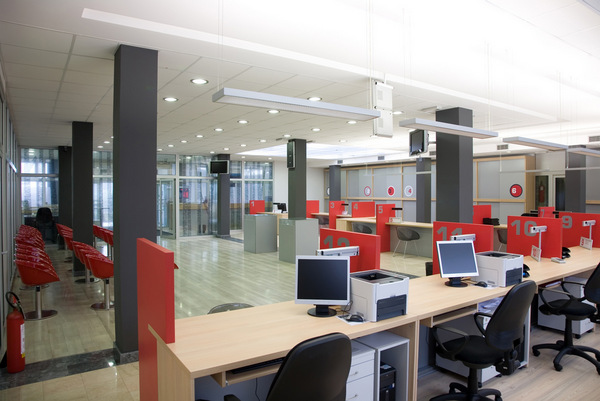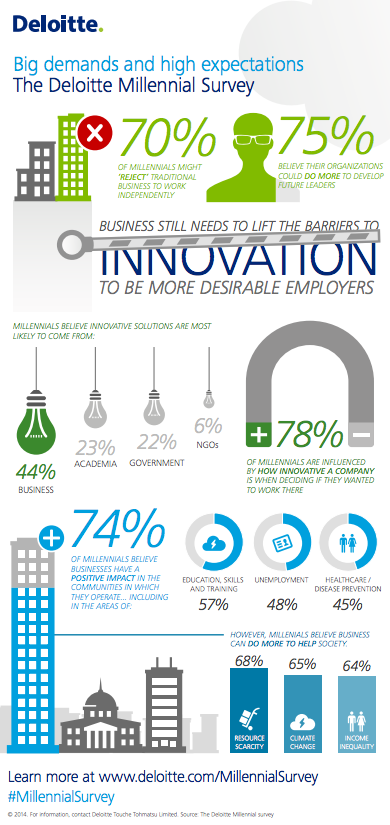Share This
Related Posts
Tags
Gen Y at Work
By Anca Gagiuc on Dec 8, 2014 in News
Generation Y is changing up the norm when it comes to where and how they live, and the Millennials have unique idea s about workspaces, too.
s about workspaces, too.
The cubicle with a desktop PC still exists, but Generation Y wants the ability to move work seamlessly across spaces and devices to unlock new levels of productivity and inspiration. Surveys show that they would accept a lower-paying job that offers flexibility with regard to where, when, and how work gets done, with continuous movement from work to personal activities and back again.
When the assigned workspace becomes obsolete; fewer employees stay in the same place all day, every day. The current needs vary from the individual desk in the quiet area, to a lounge area with sofas and chairs for a spontaneous meeting, to a formal, enclosed meeting room, to a countertop to check email or make a phone call. Traditional cubicles will still be around, available through reservation just as conference rooms are for meetings.
Supervisors and managers could see this more difficult to control, but the shift to the shared workplace and common areas makes for much more efficient utilization of valuable (and expensive) real estate.
Rose Clements, HR director of Microsoft Australia, has dealt with the experience of the shift to ABW. “It’s required us to be adaptable and agile, we’ve had to think differently how we’re onboarding people, we’ve had to think differently about the strengths that our managers need to be comfortable in managing in this kind of environment,” she said, adding that ultimately results have been positive.
Cisco Systems conducted a survey among its employees and applied the discoveries. They learned that fluidity around the office is beneficial also because it increases communication across departments and roles: a support employee can receive the needed answer on a technical issue from the engineer, or a salesperson can give immediate customer feedback to the product manager. This communication, without department barriers, helps employees gain a deeper understanding of how the business works as a whole, discover new ways of thinking and keep each other from sinking into patterns. Changing office spaces and work routine produced strong financial, operational, and recruiting results. They made public these results:
Financial Benefits
- Space reduction per person: 30%
- CAPEX reduction for furniture: 55%
- CAPEX reduction for cabling and infrastructure: 50%
- Power usage reduction, per person: 58%
- Total workplace resource cost per person: 50%
- Reduced costs for space reconfiguration
- Lower absenteeism and employee turnover rates
Operational Benefits
- Increased productivity, collaboration, and knowledge sharing among employees
- Reduced energy consumption and environmental impact (58% reduction in watts per employee)
- Reduced e-waste (fewer electronic devices dedicated per employee)
- Better positioned for business resilience, building site loss, or pandemic
- Improved ability to attract and retain employees
- Enhanced employee comfort and job satisfaction
Business resilience, teleworking, and mobility
Not tying an employee to a location keeps the business running even at times when buildings have to close, due to power failure, road snow, fire and smoke alarms, or any other local issue. Cisco states that over 70 percent of its employees work from home at least one day a week, saving about 95 minutes of commuting each day; they noticed that for every 60 minutes saved on commuting, their employees work an extra 40 minutes.
Mobility today means not just the ability to change locations, but also to move the work across devices. Start a presentation at home, adjust it at the office on a tablet, go over it on a smartphone in a cab, present it on a wide-screen Apple TV monitor or a smart TV in a conference room. Nothing is ever tied on a single device. One login allows accessing the data on any device, with seamless communication so that the employee can pick up where he/she left off, regardless of the device used.
Technology doesn’t sleep. Yes, today’s desktops are equipped with nothing more than a HDMI monitor, keyboard, mouse, and maybe a dock for the tablet, but this will soon change. Developers are already doing their best to create the best conditions for all apps – Windows, Mac, native mobile, SaaS, legacy – to work perfectly on any device.
BYOD
The idea of a standard computer already seems as odd as a company uniform. Forrester released a report reflecting that at least a quarter of a billion global information workers already practice BYOD (bring-your-own-device) policy in some way. By the looks of it, they will soon become the norm, not the exception. Specialized groups such as call centers and task workers will still need the company to provide the endpoint hardware, but these are the special cases of the BYOD era.
Generation Y-ers are digital natives; we haven’t spent many days without a device at the tip of our fingers. Our desire for flexibility doesn’t decrease our efficiency neither does it slow us down. We are curious and able to keep up with the ever changing technology industry. But our mindset is not going to change as we grow older. What’s certain is that our creativity and the wisdom and organizational knowledge of the older generation give the possibility to create a high-performing environment for the future.
How do you see the most efficient workspace?
Deloitte’s survey of 8,000 people in 26 markets and the results consistent with those from Cisco Systems.

